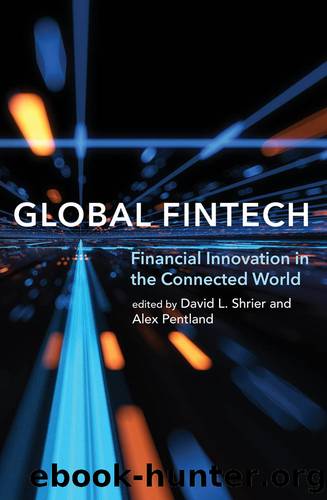Global Fintech by Shrier David L.;Pentland Alex;

Author:Shrier, David L.;Pentland, Alex;
Language: eng
Format: epub
Publisher: MIT Press
6.4âCONCLUSIONS AND STEPS FORWARD
We are only at the dawn of realizing the potential of disruptive financial technologies. The coming years will see new applications emerge, new kinds of organizations develop, and new consequences arise that will need to be dealt with by a diverse community of stakeholders.
The technological and application developments for financial innovation will inevitably be accompanied by developments in government rule setting and oversight: in short, regulation. Some of this will involve applying existing rules and oversight structures; some will involve creating new provisions that will better fit the particular needs of a technologically based application. In this chapter we have sought to provide a framework for imagining what this future interaction of financial innovations such as blockchain with government may look like, along with our admittedly speculative vision of some of the possible points of contact.
We hope that this combined exercise will be a useful starting point for further deliberation and consideration as the process goes forward. We also note the emergence of various toolkits for policy makers and encourage those toolkit creators to consider the architectural principles that we have outlined herein.
Our thinking so far has largely focused on the substance of the applicable rules. In closing, we also wish to speculate on the process by which they will be developed. We strongly urge technology advocates such as the blockchain user community to get involved, and in some cases seek partnerships, with the various points of contact in government as this goes forward. For the most part, this engagement will lead to better outcomes. The modern regulatory process often invokes a model of multistakeholder dialog, with the goal of eliciting approaches that best serve the industry as well as the public and the needs of government itself. The technical complexity of blockchain applications makes this need for engagement even more critical. Indeed, regulatory and policy bodies such as the Organisation for Economic Co-operation and Development, the European Union, and the UK government have various formal and informal consultative engagements with private-sector actors to strive for policy that considers a variety of perspectives, including that of enterprise, alongside representatives of consumer advocacy, academia, and government.
Indeed, we note that the regulatory sophistication of technology market participants varies considerably. We admonish tech start-ups to engage in a proactive rather than reactive dialog with the applicable regulators for their respective businessesâthe first contact with a regulator should not be the enforcement letter. They should also be open to hearing from those who have learned hard lessons from our financial markets even while they usefully disrupt. We also hope that those so-called entrenched interests use their positions and wisdom about financial markets carefully and avoid pushing out newcomers just to limit competition. Arguments that like activities should be regulated alike make sense if the regulation still makes sense, even if it means increased costs of entry.
A similar admonition can be aimed at governmental actors. As envisioned in such principles as those set out in Circular A-4, where possible, governmental intervention should
Download
This site does not store any files on its server. We only index and link to content provided by other sites. Please contact the content providers to delete copyright contents if any and email us, we'll remove relevant links or contents immediately.
Algorithms of the Intelligent Web by Haralambos Marmanis;Dmitry Babenko(7873)
Hadoop in Practice by Alex Holmes(5668)
Jquery UI in Action : Master the concepts Of Jquery UI: A Step By Step Approach by ANMOL GOYAL(5526)
Life 3.0: Being Human in the Age of Artificial Intelligence by Tegmark Max(4530)
Functional Programming in JavaScript by Mantyla Dan(3730)
The Age of Surveillance Capitalism by Shoshana Zuboff(3437)
Big Data Analysis with Python by Ivan Marin(3135)
Blockchain Basics by Daniel Drescher(2902)
The Rosie Effect by Graeme Simsion(2722)
Test-Driven Development with Java by Alan Mellor(2647)
WordPress Plugin Development Cookbook by Yannick Lefebvre(2634)
Hands-On Machine Learning for Algorithmic Trading by Stefan Jansen(2555)
Data Augmentation with Python by Duc Haba(2498)
Applied Predictive Modeling by Max Kuhn & Kjell Johnson(2495)
Dawn of the New Everything by Jaron Lanier(2446)
The Infinite Retina by Robert Scoble Irena Cronin(2317)
The Art Of Deception by Kevin Mitnick(2309)
Principles of Data Fabric by Sonia Mezzetta(2309)
Rapid Viz: A New Method for the Rapid Visualization of Ideas by Kurt Hanks & Larry Belliston(2208)
